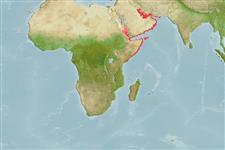Environment: milieu / climate zone / intervalo de profundidade / distribution range
Ecologia
marinhas demersal; intervalo de profundidade 20 - 50 m (Ref. 28016). Tropical; 30°N - 2°S, 32°E - 62°E
Western Indian Ocean: Persian Gulf (Ref. 3467) to the Red Sea. Lesspsian migrant in the Mediterranean (Ref. 11441).
Tamanho / Peso / Idade
Maturidade: Lm ? range ? - ? cm
Max length : 25.0 cm TL macho/indeterminado; (Ref. 30573)
Descrição breve
Chaves de identificação | Morfologia | Morfometria
Espinhos dorsais (total) : 1; Raios dorsais moles (total) : 30 - 33; Raios anais moles: 30 - 33.
Body shape (shape guide): short and / or deep.
Lives in coastal rocky substrate, usually with vegetation. Consumes small invertebrates plucked from rocks (Ref. 52629). One of the earlier Lessepsian immigrants actually well
established in the eastern part of the Mediterranean Sea and it inhabits various substrates and is usually encountered on rocky bottoms with vegetation, sandy and muddy bottoms as well as seagrass meadows (Ref. 104758).
Life cycle and mating behavior
Maturidade | Reprodução | Desova | Ovos | Fecundidade | Larvas
Hutchins, J.B., 1984. Monacanthidae. In W. Fischer and G. Bianchi (eds.) FAO species identification sheets for fishery purposes. Western Indian Ocean (Fishing Area 51). Vol. 3. FAO, Rome. pag. var. (Ref. 3467)
Categoria na Lista Vermelha da IUCN (Ref. 130435: Version 2025-1)
Ameaça para o homem
Harmless
Utilização humana
Pescarias: pouco comercial
Ferramentas
Relatórios especiais
Descarregue XML
Fontes da internet
Estimates based on models
Preferred temperature (Ref.
123201): 23.5 - 29.2, mean 26.1 °C (based on 42 cells).
Phylogenetic diversity index (Ref.
82804): PD
50 = 0.5312 [Uniqueness, from 0.5 = low to 2.0 = high].
Bayesian length-weight: a=0.01738 (0.01427 - 0.02117), b=2.92 (2.86 - 2.98), in cm total length, based on LWR estimates for this species (Ref.
93245).
Nível Trófico (Ref.
69278): 4.6 ±0.09 se; based on food items.
Resiliência (Ref.
120179): Médio, tempo mínimo de duplicação da população 1,4 - 4,4 anos (Preliminary K or Fecundity.).
Fishing Vulnerability (Ref.
59153): Low vulnerability (15 of 100).
🛈
Nutrients (Ref.
124155): Calcium = 161 [58, 382] mg/100g; Iron = 1.35 [0.56, 3.19] mg/100g; Protein = 17.1 [14.9, 19.4] %; Omega3 = 0.164 [0.063, 0.399] g/100g; Selenium = 54.6 [24.2, 127.5] μg/100g; VitaminA = 14.8 [4.3, 51.1] μg/100g; Zinc = 1.38 [0.89, 2.24] mg/100g (wet weight);
